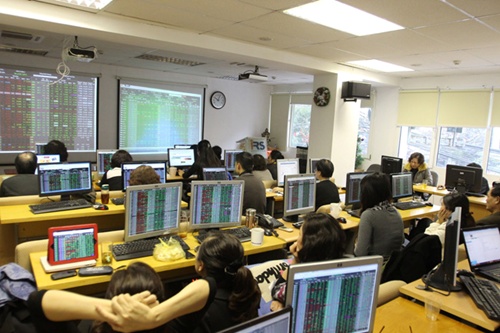Circular tightens loophole on third-party margin trading

illustration photo
By Nguyen Thi Thuy Linh - Research Department VPBank Securities Company
According to the amended Article 43, securities companies cannot use money, company property, or customers to ensure payment obligations to third parties. This is intended to constrain the margin lending activities of securities companies by preventing margin trading using loans provided by third parties.
Margin lending is currently controlled by Decision No.637/QD-UBCK (issued on August 30, 2011). The State Securities Commission (SSC) also listed stocks that can be bought through margin lending activities, and capped the lending margin at 50:50. Margin lending activities contribute a high proportion of revenues and profits of securities companies. There are two types of margin lending, and it is the second form that is affected by the amended Article 43.
First: margin lending to purchase stocks from the SSC’s allowed list, and which apply the Ministry of Finance’s (MoF) lending limits as listed above. According to statistics, this accounts for nearly 80 per cent of total margin lending in the market. Large securities companies with large equity capital have an obvious advantage over others, although for some big companies such as SSI and HSC, the ratio of margin lending-to-total equity is still low.
Second: margin lending through a third-party contract. Demand for margin lending usually increases when the stock market is in an upward trend. Beyond the overall equity capital limit, if customer demand for margin lending exceeds other limits in Article 13 of Decision 637, or the SSC margin list and ratio mentioned above, securities companies would cease being able to offer margin lending to a customer, or for a particular stock, or on an entire exchange. Securities companies might therefore ask a third party – normally a commercial bank – to lend money to customers. This co-operation is implemented through a contract between the three parties, in which securities companies will use theirs or the customers’ money or property to ensure payment obligations for the loans customers receive from the bank. If the collaterals are the securities company’s cash or assets then it is, in effect, acting as the lender for securities trading. This service is provided by both large and small brokerages to expand their loan portfolio, and to increase lending to customers to expand brokerage market share. At companies with a large capital base, the proportion of total margin lending accounted for by this service is insignificant compared with the first form of margin lending. However, at smaller firms, it can account for a large proportion of margin lending. In accordance with Circular 07, such margin lending through a third-party contract will now be prohibited.
The impacts on margin lending and the stock market depend on several factors:
I) Whether three-party contracts are re-created in other forms once they are cleared. Banks might continue lending to customers, and keep funds from being withdrawn from the market, through mechanisms such as:
(1) Brokerages becoming partnered with a fourth party, which in turn uses its assets as collateral to ensure payment obligations for customer loans. The amended Article 44 facilitates this option for brokerages.
(2) A three-party contract split into two, two-party contracts. Banks sign a lending contract with customers, and a second with brokerages so that brokerages will manage the bank’s collateral, in accordance with current regulations.
(3) Other creative lending structures.
II) Second, there is a strong likelihood that some brokerages and banks are not yet fully prepared for, or do not accept, the new approach. A portion of the margin lending under existing three-party contracts might therefore be cleared and withdrawn from the market. The difficulties in borrowing money from partners other than brokerages may push investors to shift to invest in tickers allowed by the SSC, with a lending rate of 50:50 or less. In this case, large brokerages with a margin lending ratio below the limit can meet this demand. At the same time, risks to investors using margin lending are reduced. Margin loans will continue to stay with the market.
3) Third, in the case that all three-party contracts are cleared, without being re-created under new forms, how much money is there currently in the market that will actually be withdrawn?
According to some statistics, standard margin lending provided by brokerages now accounts for nearly 80 per cent of total margin lending, and margin lending under three-party contracts for only about 20 per cent.
Assuming the total margin lending of the entire market was VND20 trillion ($899 million), then margin lending under third-party contracts would be around VND4 trillion ($180 million). This amount would have to be cleared within one to three months in accordance with contract provisions, or within two weeks to one month in accordance with private agreements between the brokerage and the client. With the current daily trading value at VND2 trillion ($89.9 million), the pressure to clear the (assumed) VND4 trillion ($180 million) would not be large. In addition, it is unlikely that the investors will rush to sell, as they are not compelled to do so.
Overall, we estimate that the impact of Circular 07 on cash flow in the stock market is not significant.
What the stars mean:
★ Poor ★ ★ Promising ★★★ Good ★★★★ Very good ★★★★★ Exceptional
Latest News
More News
- SHB honoured at VLCAs for fourth time (November 22, 2024 | 19:08)
- Central Bank of Cuba chief visits Hanoi to work with VBSP (November 22, 2024 | 15:49)
- Credit sees steady growth towards year-end (November 21, 2024 | 17:46)
- HDBank wins three titles at Vietnam Listed Company Awards (November 21, 2024 | 10:01)
- VLCA’s corporate governance mission (November 21, 2024 | 10:00)
- The promotion of ESG via banking (November 21, 2024 | 09:32)
- Standard Chartered committed to Vietnam’s financial success (November 21, 2024 | 09:24)
- Full ESG adoption the priority for Agribank (November 21, 2024 | 09:07)
- Banks entice youth with tech advances (November 21, 2024 | 08:00)
- Banks shaping the future as business advisors (November 20, 2024 | 21:00)




















 Mobile Version
Mobile Version